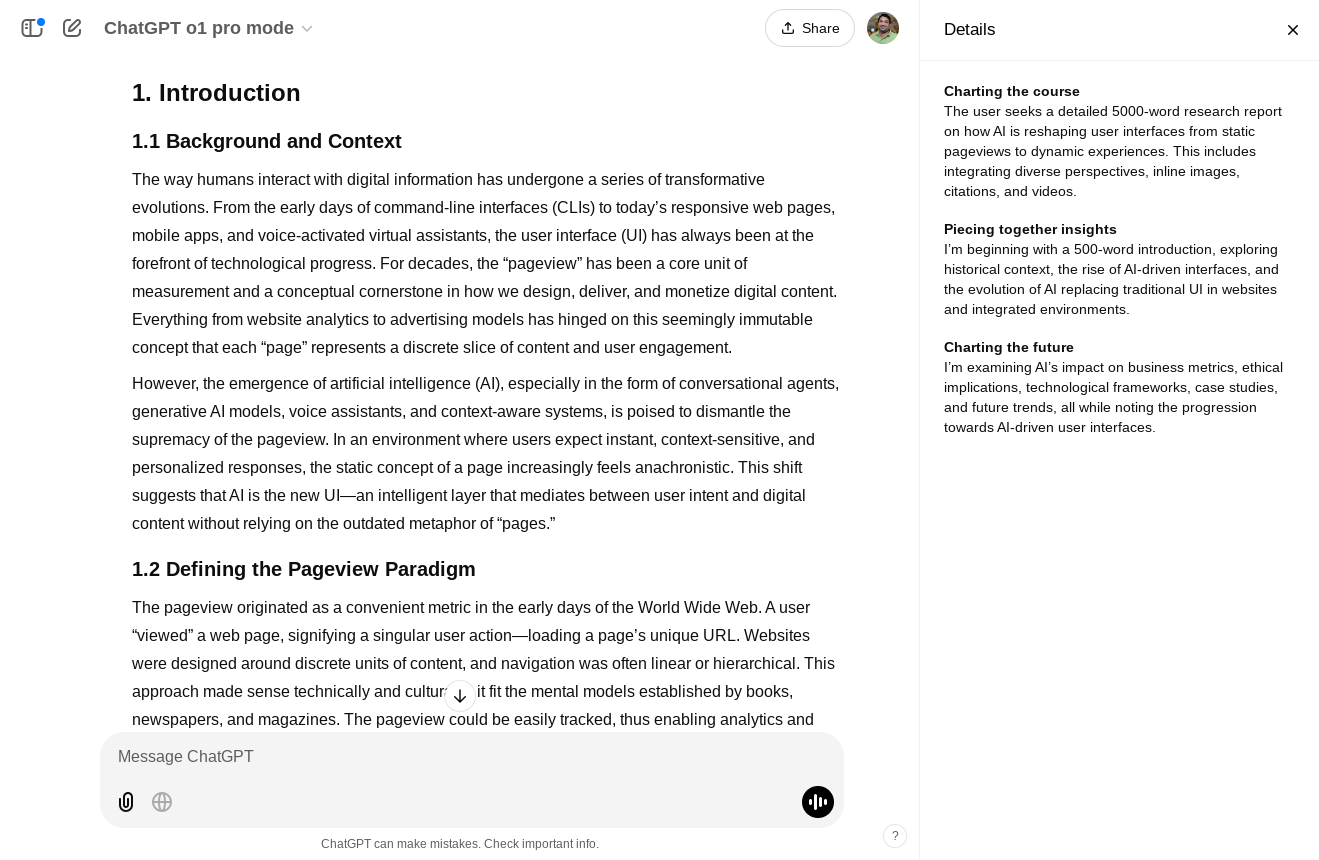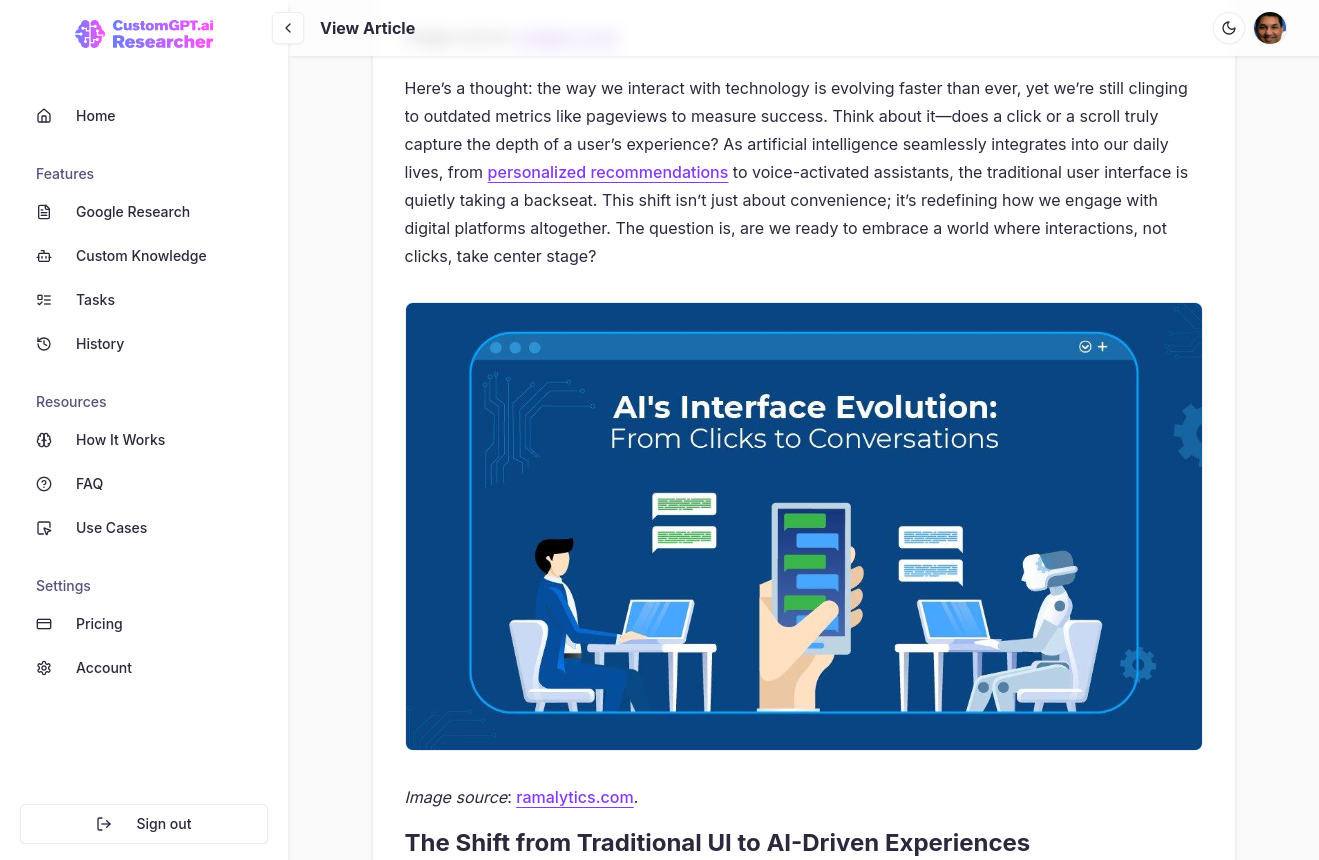ChatGPT vs CustomGPT.ai Researcher
When it comes to creating research-backed content, understanding the differences between general-purpose AI like ChatGPT and specialized research tools like CustomGPT.ai Researcher is crucial for making informed decisions. This comparison explores key aspects of both platforms to help you choose the right tool for your needs.
Core Capabilities Comparison
| Feature | ChatGPT | CustomGPT.ai Researcher |
|---|---|---|
| Primary Purpose | General-purpose conversational AI model designed for diverse tasks | Specialized research platform built specifically for deep content research |
| Knowledge Cutoff | Fixed training data cutoff without updates | Real-time access to current information via live search |
| Source Access | Limited to training data without verification | Processes 200+ current authoritative sources |
| Research Depth | Surface-level information from training | Analyzes 1.4M+ words per research topic |
| Source Citations | No direct source citations available | Inline citations for every factual claim |
| Processing Time | Immediate responses without verification | 38-minute average for comprehensive research |
| Content Length | Limited by context window | Full research reports (6,000+ words) |
| Visual Content | Text-only output | AI-enhanced visual image integration |
Visual Interface Comparison
ChatGPT Interface
Standard chat interface designed for quick Q&A and general conversation.

CustomGPT.ai Researcher Interface
Research-focused interface with progress tracking and detailed source analysis.

Technical Architecture
The underlying technology stack significantly impacts each tool's research capabilities and output quality. These architectural differences explain the variations in performance, accuracy, and reliability between the platforms.
| Component | ChatGPT | CustomGPT.ai Researcher |
|---|---|---|
| AI Models | Single general-purpose LLMs (GPT-4o, o1) for all tasks | Multiple specialized models: o1 for reasoning, gpt-4o for generation, CustomGPT.ai for RAG |
| Knowledge Base | Static training data without realtime updates or verification | Dynamic RAG technology with real-time source processing and verification |
| Content Generation | Single-pass generation without refinement or fact-checking | Progressive section-by-section writing with continuous source verification |
| Source Handling | No access to source materials or citation capabilities | Comprehensive citation tracking with inline source references |
| Verification System | No built-in fact-checking or verification mechanisms | Industry-leading anti-hallucination technology with continuous accuracy checks |
| Context Management | Limited by fixed context window | Processes 1.4M+ words across 200+ sources per article |
| Update Capability | Fixed knowledge cutoff without updates | Real-time access to current information via live search |
Content Quality Comparison
Content quality directly impacts the usability and credibility of your research output. This comparison examines how each tool handles accuracy, depth, and verification to ensure reliable results.
| Aspect | ChatGPT | CustomGPT.ai Researcher |
|---|---|---|
| Research Process | Uses pre-trained knowledge without realtime updates or verification | Conducts real-time research across authoritative databases |
| Source Validation | Cannot verify current information or recent developments | Analyzes 200+ authoritative sources per research topic |
| Accuracy Control | Risks generating hallucinations on technical topics | Employs anti-hallucination technology with source verification |
| Citation Handling | No ability to provide verifiable sources | Complete citation system with links to original materials |
| Processing Depth | Limited by context window and training data | Processes 1.4M+ words per article for comprehensive coverage |
Content Generation Capabilities
The ability to transform research into coherent, well-structured content is essential for creating professional documentation. These capabilities determine the quality of final output and required post-processing effort.
| Feature | ChatGPT | CustomGPT.ai Researcher |
|---|---|---|
| Response Style | Quick, conversational responses without deep research | Comprehensive reports with thorough source analysis |
| Content Depth | Limited by pre-trained knowledge | Deep analysis incorporating multiple expert perspectives |
| Fact Checking | No verification against current sources | Continuous verification against authoritative sources |
| Document Structure | Basic formatting without professional standards | Professional formatting with clear section progression |
| Visual Elements | Text-only output | AI-selected relevant visuals and formatting |
Use Case Applications
Different research tasks demand different tool capabilities. Understanding which platform excels at specific use cases helps optimize your workflow and ensure high-quality output for each project type.
| Use Case | ChatGPT | CustomGPT.ai Researcher |
|---|---|---|
| Research Reports | Basic information gathering without verification | Comprehensive research with extensive source verification |
| Academic Content | Simple summaries without citations | Literature reviews with proper citations |
| Market Analysis | General market information from training data | Detailed analysis backed by current market data |
| Technical Documentation | Basic technical descriptions | Verified technical content with proper attribution |
| Content Marketing | Short-form content without citations | SEO-optimized long-form content with inline external links |
Business Value Analysis
Understanding the return on investment and resource efficiency is crucial for making informed tool choices. This analysis helps evaluate total cost of ownership and potential time savings.
| Aspect | ChatGPT | CustomGPT.ai Researcher |
|---|---|---|
| Time Investment | Quick responses but needs manual verification | 38-minute average for complete research reports |
| Resource Efficiency | Requires significant human oversight | Automated research saves 20+ hours per report |
| Quality Assurance | Manual fact-checking needed | Built-in verification and anti-hallucination |
| Process Management | No integrated research workflow | End-to-end research and content generation |
| Enterprise Scaling | Limited scaling capabilities | Full enterprise features with team collaboration |
| ROI Profile | Lower upfront cost but higher manual effort | Higher initial investment with significant time savings |
Integration Features
Integration capabilities affect how easily each tool fits into existing workflows and systems. These features impact team adoption and overall productivity improvements.
| Feature | ChatGPT | CustomGPT.ai Researcher |
|---|---|---|
| Access Methods | Web interface or basic API | Multiple delivery options including email and dashboard |
| Document Management | No built-in management system | Google Drive integration with version control |
| Team Collaboration | Limited sharing capabilities | Full team collaboration via Google Docs |
| Output Formats | Basic text output | Multiple export formats (Word, Markdown, HTML) |
| Visual Integration | No visual content support | Automated visual enhancement with AI selection of images |
Conclusion
This summary helps you choose the right tool based on your specific research and content creation needs. Consider these key differentiators when making your decision.
| Aspect | ChatGPT | CustomGPT.ai Researcher |
|---|---|---|
| Best Use Cases | Quick answers, brainstorming, basic writing tasks | Deep research, verified content, enterprise projects |
| Time Investment | Minutes for basic tasks, hours for verification | 38 minutes for comprehensive research |
| Output Quality | Basic content without citations | Verified content with source citations |
| Team Usage | Individual use, limited collaboration | Enterprise-ready with team features |
| Research Depth | Surface-level from training data | 1.4M+ words across 200+ sources |
| Cost-Benefit | Lower cost, higher manual effort | Higher value for serious research |